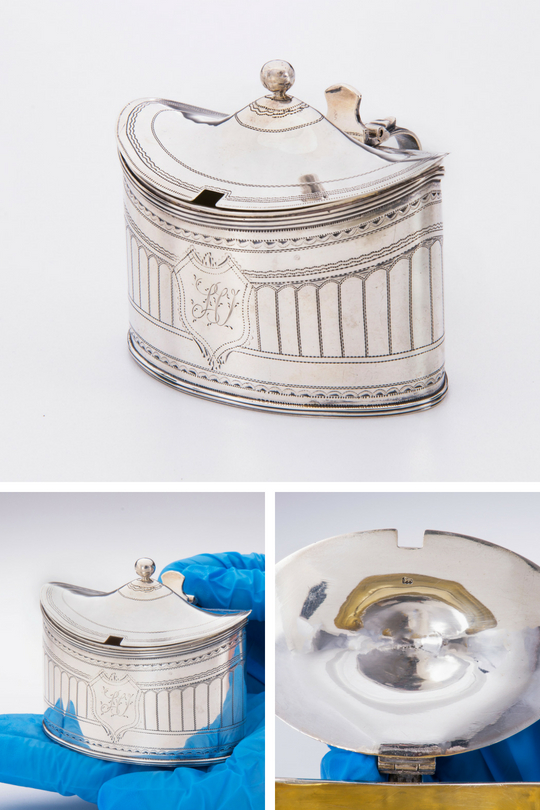An elegant mustard pot from a seigneurial manor
The Canadian Museum of History recently acquired a small silver dish associated with the history of the seigneurial system in Canada. It is a neo-Georgian mustard pot, and the engraved monogram it bears — “S.O.” — indicates that it once belonged to the Saint-Ours, a seigneurial family.
Made in London, England, in 1797, the pot was reworked by Paul Morin, a silversmith in Québec City. It was thus “Canadianized” by being modified and used in the very specific context of the seigneurial system. In Lower Canada, in the early 19th century, mustard was consumed by people of all walks of life, but few had the privilege of owning silverware.
The first seigneur in the Saint-Ours family was Pierre de Saint-Ours, a nobleman and captain in the Carignan-Salières Regiment who arrived in Canada in 1665. Shortly thereafter, he moved onto the seigneury granted to him by Intendant Jean Talon, located in the Richelieu River area. At the time, seigneurs were required to help settle their seigneuries, under the auspices of the King of France. The Saint-Ours stayed in the colony after the Treaty of Paris was signed in 1763. They quickly formed an alliance with the new British colonial elite, as did several other seigneurial families, and carried on the family’s military tradition.

This mustard pot was manufactured in London, England, by Alexander Field in 1797 and reworked in Québec City by silversmith Paul Morin between 1800 and 1815. Canadian Museum of History, 2017.62.2
Seigneur Charles de Saint-Ours (1753–1834), who was also an officer and politician, had a new manor house built starting in 1792. Around that time, he married Josephte Murray, great-niece of General James Murray, the first British governor of Québec City. The Saint-Ours often received members of the elite at their manor. The silver mustard pot, most likely acquired in the days of Charles de Saint-Ours, gives an indication of the prestigious surroundings in which the condiment was consumed: at a seigneurial manor, by a family who had several servants and occasionally received distinguished guests. Silverware was a symbol of social status and reflected a desire to distinguish oneself from other people, especially the censitaires, the tenant farmers who occupied the seigneury’s lands but did not own them.
For over 45 years, Charles de Saint-Ours devoted himself to the development of his seigneury. In 1815, Joseph Bouchette stated the following about the Saint-Ours seigneury: “Under the various considerations of extent, situation, local advantages, the quantity of lands in cultivation, the state of husbandry, and the population, which amounts to 3,000 souls, there are certainly but few possessions in the province superior in value to this one.” Because the development of the seigneuries varied greatly over time and from one region to another, the Saint-Ours seigneury is not necessarily a typical example. The seigneurial family bequeathed its name and its coat of arms to the present-day city of Saint-Ours, Quebec.
When Canada became a British colony, there were about 250 seigneuries in the Saint Lawrence Valley, and the seigneurial system endured there long after the Conquest. At the time, it was on the decline in England, and it would be abolished in France by the Revolution. Some of the settlers who arrived from Britain also became seigneurs, including Scottish officers Malcolm Fraser and John Nairne in Murray Bay La Malbaie.
In Quebec, the abolition of the seigneurial system did not begin until 1854, when the Act for the Abolition of Feudal Rights and Duties in Lower Canada was passed. However, some former censitaires continued to pay rent until 1940, and others paid a municipal tax until 1970 to compensate former seigneurs. In certain localities, the members of some seigneurial families were called seigneurs and seigneuresses until very recently.
The Museum’s collection includes many items that reflect the way of life of this elite of days gone by. In addition to the mustard pot, there are decorative objects, silverware, furniture, a harp that belonged to Caroline-Virginie de Saint-Ours (Charles de Saint-Ours’s granddaughter) and clothing that belonged to members of the Nairne family, likely worn at the seigneurial manor house in La Malbaie.
The mustard pot is currently on view in the exhibition Medieval Europe – Power and Splendour until January 20, 2019.